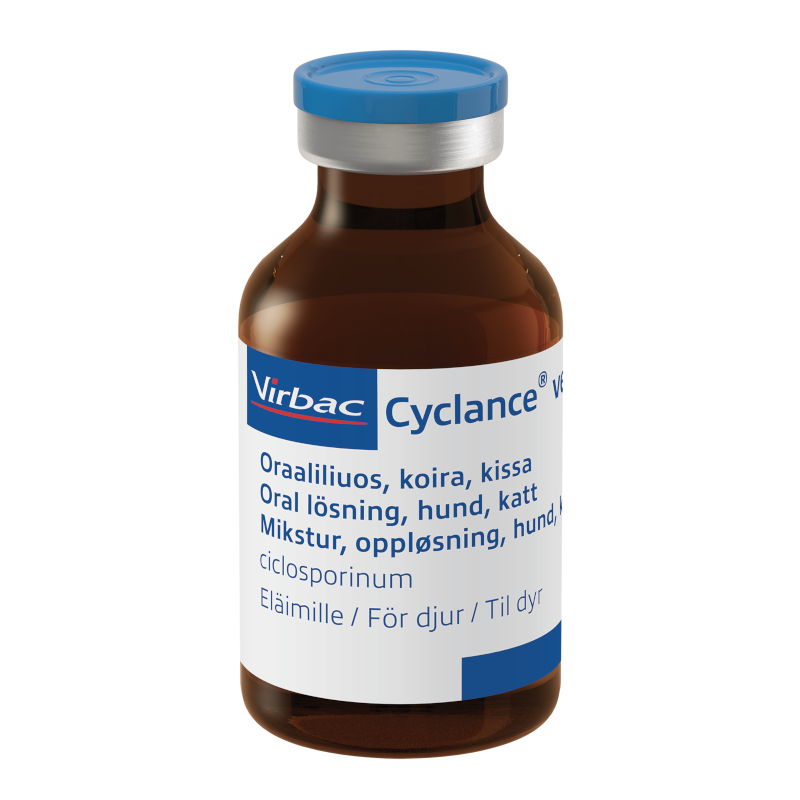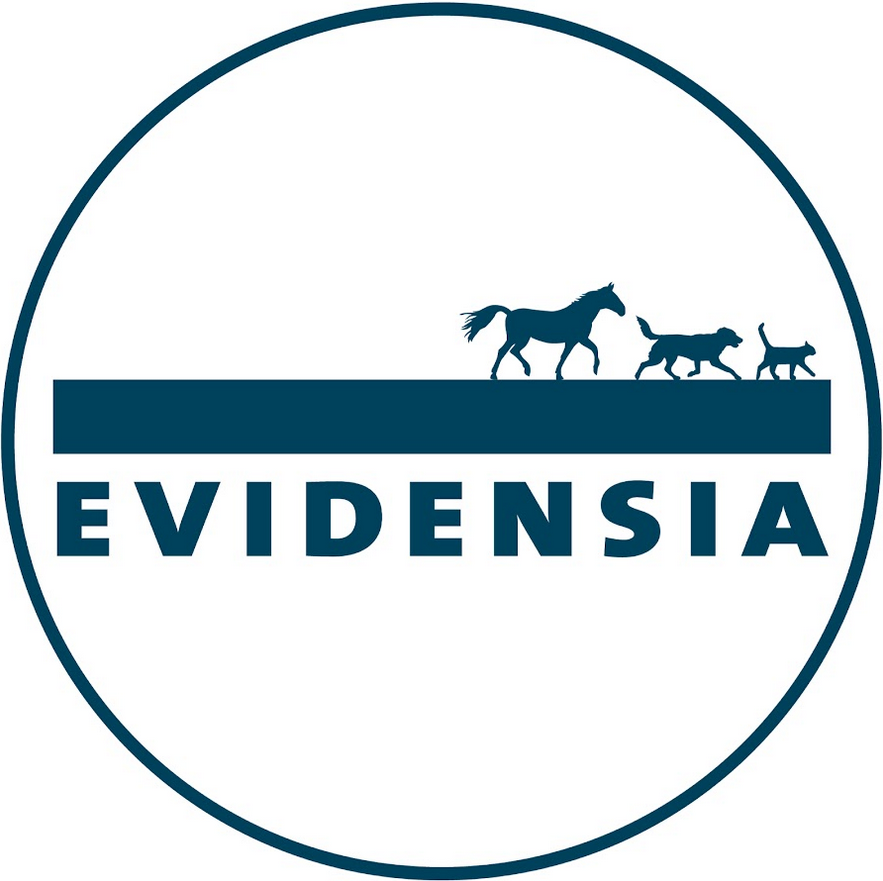Cyclance vet.
Innholdstoffer
ATC-kode
Dyrearter
Dogs and cats.
Indikasjoner
Treatment of chronic manifestations of atopic dermatitis in dogs. Symptomatic treatment of chronic allergic dermatitis in cats.
Dosering og tilførselvei
For oral use.
Before starting treatment, an evaluation of all alternative treatment options should be made.
Before administration, the body weight of animals has to be accurately determined.
Dogs:
The recommended dose of ciclosporin is 5 mg/kg body weight (0.05 ml of oral solution per kg BW) and should initially be administered daily. The frequency of administration should subsequently be reduced depending on the response.
The veterinary medicinal product should initially be given daily until a satisfactory clinical improvement is seen. This will generally be the case within 4-8 weeks. If no response is obtained within the first 8 weeks, the treatment should be stopped.
Once the clinical signs of atopic dermatitis are satisfactorily controlled, the veterinary medicinal product can then be given every second day. The veterinarian should perform a clinical assessment at regular intervals and adjust the frequency of administration to the clinical response obtained.
In some cases where the clinical signs are controlled with every second day dosing, the veterinary surgeon can decide to give the product every 3 to 4 days. The lowest effective frequency of dosing should be used to maintain the remission of clinical signs.
Patients should be regularly re-evaluated and alternative treatment options reviewed. Adjunct treatment (e.g. medicated shampoos, fatty acids) may be considered before reducing the dosing interval.
The duration of treatment should be adjusted according to treatment response. Treatment may be stopped when the clinical signs are controlled. Upon recurrence of clinical signs, treatment should be resumed at daily dosing, and in certain cases repeated treatment courses may be required.
Dosages for dogs:
At standard dosage of 5mg/kg
Weight (kg) | 2 | 3 | 4 | 5 | 6 | 7 | 8 | 9 | 10 | |
Dosage (ml) | 0.1 | 0.15 | 0.2 | 0.25 | 0.3 | 0.35 | 0.4 | 0.45 | 0.5 | |
Weight (kg) | 11 | 12 | 13 | 14 | 15 | 16 | 17 | 18 | 19 | 20 |
Dosage (ml) | 0.55 | 0.6 | 0.65 | 0.7 | 0.75 | 0.8 | 0.85 | 0.9 | 0.95 | 1 |
Weight (kg) | 21 | 22 | 23 | 24 | 25 | 26 | 27 | 28 | 29 | 30 |
Dosage (ml) | 1.05 | 1.1 | 1.15 | 1.2 | 1.25 | 1.3 | 1.35 | 1.4 | 1.45 | 1.5 |
Weight (kg) | 31 | 32 | 33 | 34 | 35 | 36 | 37 | 38 | 39 | 40 |
Dosage (ml) | 1.55 | 1.6 | 1.65 | 1.7 | 1.75 | 1.8 | 1.85 | 1.9 | 1.95 | 2 |
Weight (kg) | 41 | 42 | 43 | 44 | 45 | 46 | 47 | 48 | 49 | 50 |
Dosage (ml) | 2.05 | 2.1 | 2.15 | 2.2 | 2.25 | 2.3 | 2.35 | 2.4 | 2.45 | 2.5 |
Weight (kg) | 51 | 52 | 53 | 54 | 55 | 56 | 57 | 58 | 59 | 60 |
Dosage (ml) | 2.55 | 2.6 | 2.65 | 2.7 | 2.75 | 2.8 | 2.85 | 2.9 | 2.95 | 3 |
Weight (kg) | 61 | 62 | 63 | 64 | 65 | 66 | 67 | 68 | 69 | 70 |
Dosage (ml) | 3.05 | 3.1 | 3.15 | 3.2 | 3.25 | 3.3 | 3.35 | 3.4 | 3.45 | 3.5 |
Weight (kg) | 71 | 72 | 73 | 74 | 75 | 76 | 77 | 78 | 79 | 80 |
Dosage (ml) | 3.55 | 3.6 | 3.65 | 3.7 | 3.75 | 3.8 | 3.85 | 3.9 | 3.95 | 4 |
For the 30 and 60 ml bottles, either the 1 ml oral syringe (graduated every 0.05 ml) or the 2 ml oral syringe (graduated every 0.1 ml) can be used to achieve the dose stated above, determined according to bodyweight.
PRIMARY PACKAGING TYPE 2For the 30 and 50 ml bottles, either the 1 ml oral syringe (graduated every 0.05 ml) or the 3 ml oral syringe (graduated every 0.1 ml) can be used to achieve the dose stated above, determined according to bodyweight.
Cats:
The recommended dose of ciclosporin is 7 mg/kg body weight (0.07 ml of oral solution per kg) and should initially be administered daily.
The frequency of administration should subsequently be reduced depending on the response.
The veterinary medicinal product should initially be given daily until a satisfactory clinical improvement is seen (assessed by intensity of pruritus and lesion severity - excoriations, miliary dermatitis, eosinophilic plaques and/or self-induced alopecia). This will generally be the case within 48 weeks. Severe prolonged pruritus may induce a state of anxiety and subsequent excessive grooming behaviour. In such cases, despite an improvement in pruritus upon administration of the treatment, the resolution of self-induced alopecia may be delayed.
Once the clinical signs of allergic dermatitis are satisfactorily controlled, the veterinary medicinal product can then be given every second day. In some cases where the clinical signs are controlled with every second day dosing, the veterinary surgeon can decide to give the product every 3 to 4 days. The lowest effective frequency of dosing should be used to maintain the remission of clinical signs. Patients should be regularly re-evaluated and alternative treatment options reviewed. The duration of treatment should be adjusted according to treatment response. Treatment may be stopped when the clinical signs are controlled. Upon recurrence of clinical signs, treatment should be resumed at daily dosing, and in certain cases repeated treatment courses may be required.
The veterinary medicinal product can be given either mixed with food or directly into the mouth. If given with food, the solution should be mixed with a small amount of food, preferably after a sufficient period of fasting to ensure complete consumption by the cat. Should the cat not accept the product mixed with food, it should be given by inserting the oral syringe directly into the cat’s mouth and delivering the entire dose. In case the cat only partially consumes the product mixed with food, administration of the veterinary medicinal product with the oral syringe should be resumed only the next day. Any uneaten medicated cat food must be disposed of immediately and the bowl washed thoroughly.
The efficacy and tolerability of this veterinary medicinal product was demonstrated in clinical studies with a duration of 4.5 months.
Dosage for cats:
As the efficacy and safety of ciclosporin have not been assessed in cats weighing less than 2.3 kg (see section 4.5), administration of the veterinary medicinal product to cats weighing less than 2.3 kg should be according to a benefit-risk assessment by the responsible veterinarian.
At standard dosage of 7 mg/kg
Weight (kg) | 2.1 | 2.9 | 3.6 | 4.3 | 5.0 | 5.7 | 6.4 | 7.1 |
Dosage (ml) | 0.15 | 0.20 | 0.25 | 0.30 | 0.35 | 0.40 | 0.45 | 0.50 |
Weight (kg) | 7.9 | 8.6 | 9.3 | 10.0 | 10.7 | 11.4 | 12.1 | 12.8 | 13.6 | 14.3 |
Dosage (ml) | 0.55 | 0.60 | 0.65 | 0.70 | 0.75 | 0.80 | 0.85 | 0.90 | 0.95 | 1.00 |
For the 30 and 60 ml bottles, either the 1 ml oral syringe (graduated every 0.05 ml) or
the 2 ml oral syringe (graduated every 0.1 ml) can be used to achieve the dose stated above, determined according to bodyweight.
PRIMARY PACKAGING TYPE 2For the 30 and 50 ml bottles, either the 1 ml oral syringe (graduated every 0.05 ml) or the 3 ml oral syringe (graduated every 0.1 ml) can be used to achieve the dose stated above, determined according to bodyweight.
INSTRUCTIONS FOR USEDogs: The veterinary medicinal product should be given at least 2 hours before or after feeding. Insert the oral syringe directly into the dog’s mouth.
Cats: The product can be given either mixed with food or directly into the mouth in cats.
1 Push and turn the child-resistant screw cap to open the bottle.
Always close the bottle with the child-resistant screw cap after use. | 2 Keep the bottle upright and insert the oral dosing syringe firmly into the plastic adapter.
| |||
3 Turn the bottle upside down and slowly pull the plunger up so that the oral dosing syringe fills with the product. Withdraw the dose of medicine prescribed by your veterinarian.
| 4 Return the bottle to its upright position and remove the oral dosing syringe by gently twisting it out of the plastic adapter.
| |||
5 You can now introduce the syringe in the mouth of your animal and push the medicine out of the syringe. Do not rinse or clean the oral dosing syringe between uses.
Note: If the prescribed dose is more than the maximum volume marked on the oral dosing syringe, you will need to reload the syringe to withdraw the full dose. Note: For cats, you can also give the product mixed with food
| 6 Always close the bottle with the child-resistant screw cap after use. To provide a child-resistant closure, push down on the child-resistant screw cap as you turn it.
Keep out of the sight and reach of children | |||
1 Retrieve the plastic cap and insert firmly the plastic dispenser.
The plastic dispenser should remain in place. | 2 Keep the bottle upright and insert the oral dosing syringe firmly into the plastic dispenser.
| |
3 Turn the bottle upside down and slowly pull the plunger up so that the oral dosing syringe fills with the product. Withdraw the dose of medicine prescribed by your veterinarian.
Return the bottle to its upright position and remove the oral dosing syringe by gently twisting it out of the plastic dispenser. | 4 You can now introduce the syringe in the mouth of your animal and push the medicine out of the syringe. Do not rinse or clean the oral dosing syringe between uses.
Note: If the prescribed dose is more than the maximum volume marked on the oral dosing syringe, you will need to reload the syringe to withdraw the full dose. Note: For cats, you can also give the product mixed with food
| |
Keep out of the sight and reach of children
If necessary, the user can wipe the outside of the oral syringe with a dry tissue and dispose of used tissue immediately.
Bivirkninger
Regarding malignancy, please see sections 3.3 “Contraindications” and 3.5 “Special precautions for use”.
Dogs:
Uncommon (1 to 10 animals / 1,000 animals treated): | Digestive tract disorders (e.g. vomiting, mucous stool, loose stool and diarrhoea)2,4, Lethargy4, Anorexia4 Hyperactivity4, Gingival hyperplasia1,4, Skin reactions (e.g. verruciform lesion or hair change)4, Pinnal reddening and Pinnal oedema4, Muscle weakness or Muscle cramps4 |
Very rare (<1 animal / 10,000 animals treated, including isolated reports): | Diabetes mellitus3 |
Undetermined Frequency | Hypersalivation2,4 |
1Mild and moderate.
2Mild and transient and generally do not require the cessation of the treatment.
3Especially in West Highland White Terriers.
4Generally resolve spontaneously after treatment is stopped.
Cats:
Very common (>1 animal / 10 animals treated): | Digestive tract disorders (e.g. vomiting and diarrhoea), Weight loss1 |
Common (1 to 10 animals / 100 animals treated): | Increased appetite, Lethargy, Anorexia, Hypersalivation, Hyperactivity, Polydipsia, Gingival hyperplasia and Lymphopaenia2 |
1Generally mild and transient and do not require the cessation of the treatment.
2Generally resolve spontaneously after treatment is stopped or following a decrease in the dosing frequency.
Side effects may be severe in individual animals.
Reporting adverse events is important. It allows continuous safety monitoring of a veterinary medicinal product. Reports should be sent, preferably via a veterinarian, to either the marketing authorisation holder or its local representative or the national competent authority via the national reporting system. See the package leaflet for respective contact details.
Utlevering
Reseptgruppe C
| PRIS | Prisene er kun synlige for fagpersoner. Opprett din GRATIS profil på VETiSearch i dag.. Logg inn |
|---|---|
| VNR | 538758 |
| EAN | 7046265387589 |













 VERIFISERTE DATA
VERIFISERTE DATA










